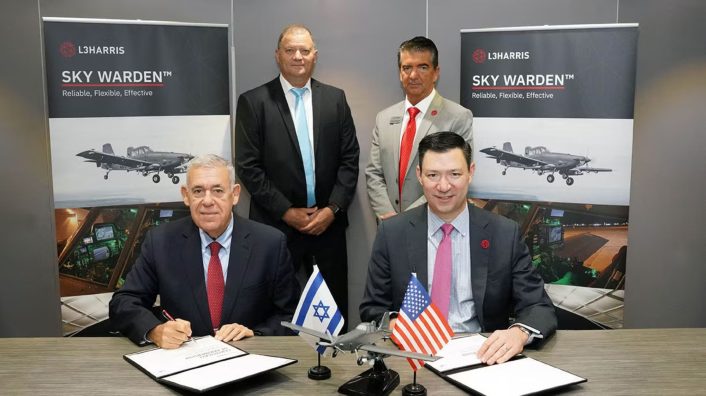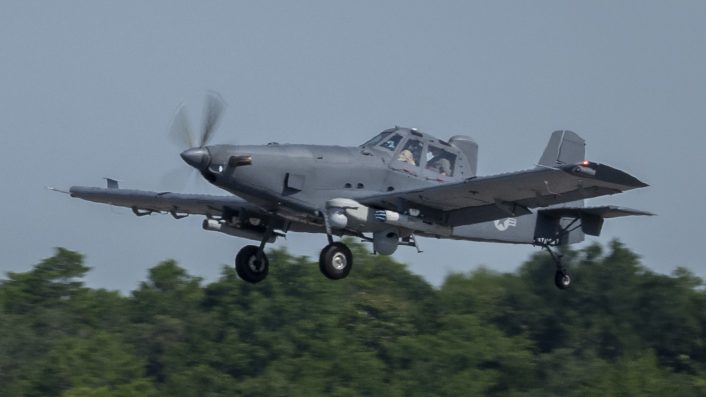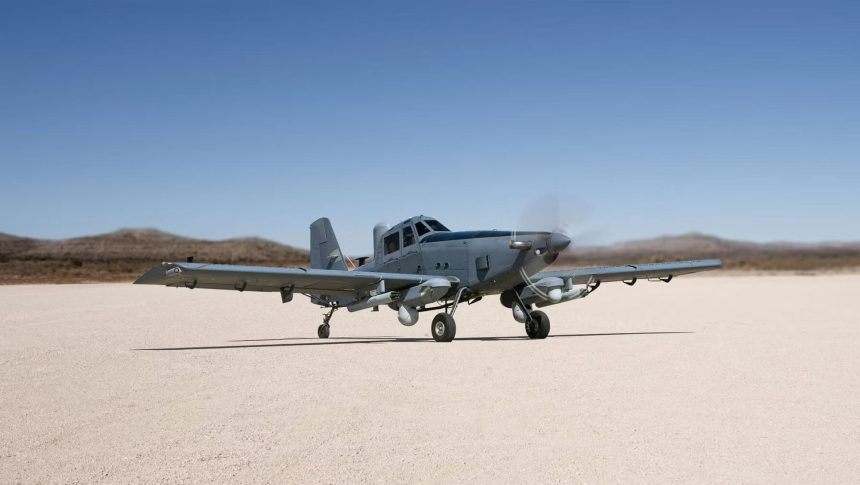The Sky Warden’s Israeli variant will integrate IAI’s mission systems, hardware and software.
Israel will acquire a customized variant of L3Harris’ Sky Warden light attack aircraft, which will be locally designated the Blue Sky Warden, according to a MoU (Memorandum of Understanding) signed between L3Harris and Israel Aerospace Industries (IAI) on Oct. 15, 2025. The number of aircraft Israel plans to acquire is currently not known.
Part of the Israeli Light-Attack Aircraft Program, the aircraft will have “Israel-specific” software, hardware and mission systems designed and developed by IAI, according to the joint release by L3Harris and IAI. After supplying and integrating its mission equipment, IAI will also “lead flight tests and airworthiness campaigns with the Ministry of Defense and the Israeli Air Force.”
The Sky Warden is a missionized derivative of the Air Tractor AT-802U cropduster. Called the OA-1K Skyraider II by the U.S. AFSOC (Air Force Special Operations Command), the aircraft was developed in response to the command’s Armed Overwatch program in 2022.
AFSOC revealed the ‘Skyraider II’ designation for the aircraft during the Special Air Warfare Symposium on Feb. 27, 2025. The name revives the legacy of the rugged and versatile A-1 Skyraider, which served from 1946 through the early 1980s.
L3Harris-IAI agreement
The press release by L3Harris included among the Israel-specific capabilities IAI’s “open-architecture mission computer.” The statement quoted IAI’s president and CEO Boaz Levy, who called L3Harris a “long-standing and trusted partner with whom we have successful partnerships on several fronts.”

“By combining IAI’s cutting-edge systems and expertise in mission systems integration with L3Harris’ Sky Warden platform, we are delivering a tailored solution that meets the evolving needs of the Ministry of Defense and Israeli Air Force,” said Levy.
“This strategic partnership with IAI allows us to provide a tailored variant of our Sky Warden to meet Israel’s operational and industrial needs,” said Jon Rambeau, President, Integrated Mission Systems, L3Harris. “The Sky Warden light-attack aircraft delivers the best-in-class endurance, payload and survivability needed for airborne ISR and other missions.”
Simplify and act. Widow mission execution software simplifies complex data into a common operating picture, allowing users to tailor their interface and receive enhanced situational awareness. Learn more: https://t.co/V3Ugv4hVLA#AUSA2025 pic.twitter.com/LlafVAdw15
— L3Harris (@L3HarrisTech) October 11, 2025
L3Harris’ and IAI’s other areas of collaboration include the Phoenix CAEW&C (Conformal Airborne Early Warning and Control) aircraft based on the Bombardier Global 6500 business jet. South Korea chose the Phoenix CAEW&C as its next airborne radar on Sep. 30, following a competitive bidding.
The Israeli companies are the developers of the EL/W-2085 CAEW AESA (Active Electronically Scanned Array) radar used by the Phoenix as well as the standard CAEW, which is in service in Israel, Italy (as E-550A CAEW) and Singapore. This aircraft is based on the Gulfstream G-550 business jet.
The selection of the Sky Warden aircraft also comes after L3Harris announced on Aug. 27, 2025, an expanded production facility for the aircraft in Waco, Texas. However, the U.S. SOCOM (Special Operations Command) reduced its annual procurement for the OA-1K.
Air & Space Forces Magazine reported only six aircraft were funded in Fiscal Year 2026, down from the previously planned 12, itself reduced from 15 aircraft in FY2025. The command’s overall program of record, however, remains 75 aircraft.

Tactical use
The choice of Israeli avionics, sensors and mission systems on the Blue Sky Warden also has a precedent in the country ensuring heavy customization of U.S. products with its technologies. A prime example remains the F-35A, locally designated the F-35I after it received unidentified Israeli-made technologies, making Israel the only country to have modified the stealth fighter.
Complementing modifications are also present on the Israeli Air Force’s F-15I Ra’am and F-16I Sufa to support networking, data sharing and interoperability with the F-35Is. The Blue Sky Warden would also be more suited for lower intensity operations in permissive, uncontested environments, instead of the outsized F-15s and F-16.
The next fight won’t wait for a runway. It demands an aircraft that can launch from anywhere, connect across the battlespace in real time, & deliver decisive effects – all with a smaller footprint & lower cost. Learn more about Sky Warden: https://t.co/DkuS1d4Pcf#SOFWeek pic.twitter.com/iVS92LeEKs
— L3Harris (@L3HarrisTech) May 7, 2025
A heavily modernized turboprop CAS aircraft equipped with advanced optical, communications and targeting sensors allows for more precise reconnaissance-strike operations, avoiding collateral damage. With two powerful optical sensors, the Wescam MX-15 and MX-20, on the port-side wing’s MMSP (Multi-Modal Sensor Pod) – assuming the Blue Sky Warden would retain that capability, the aircraft would be suited for medium-altitudes, all-weather, day/night ISR-strike roles.
Should the need arise, it can also help to optimally use larger and heavier platforms like the F-15, F-16 and the AH-64 Apache by serving as a targeting data relay point closer to the action.
Get an inside look at Sky Warden aircraft, the proven baseline for @AFSpecOpsCmd’s OA-1K Skyraider II. Learn more: https://t.co/rV407KnIRq#AFANational pic.twitter.com/q5DcQMKgYF
— L3Harris (@L3HarrisTech) September 19, 2025
Weapons payloads and lessons from current wars
It is sufficient to say the platform may have been identified after lessons learnt in the three years of operations against Hamas in the west, the Houthis in the south and Hezbollah in the north. Primarily, the Skyraider II’s ability to carry two seven-round LAU-131 A/A pods with APKWS II rockets allows cheaper interception of Houthi One-Way Attack drones, instead of the larger F-15s, F-16s or Apache helicopters.
As it now turns out, even A-10s in the CENTCOM (Central Command) AOR (Area of Responsibility) have been used against drones, showing how the cost asymmetry still persists between the threats and the platforms used to stop them.
The possibility that the Blue Sky Wardens would fire the Israeli Spike NLOS (Non-Line of Sight), in place of the AGM-114 Hellfire, also cannot be ruled out. Needless to say, the developmental testing of the OA-1K Skyraider II at Eglin AFB, Florida, from late June will also help its rapid operationalization with the Israelis, with readily available testing and performance data.









